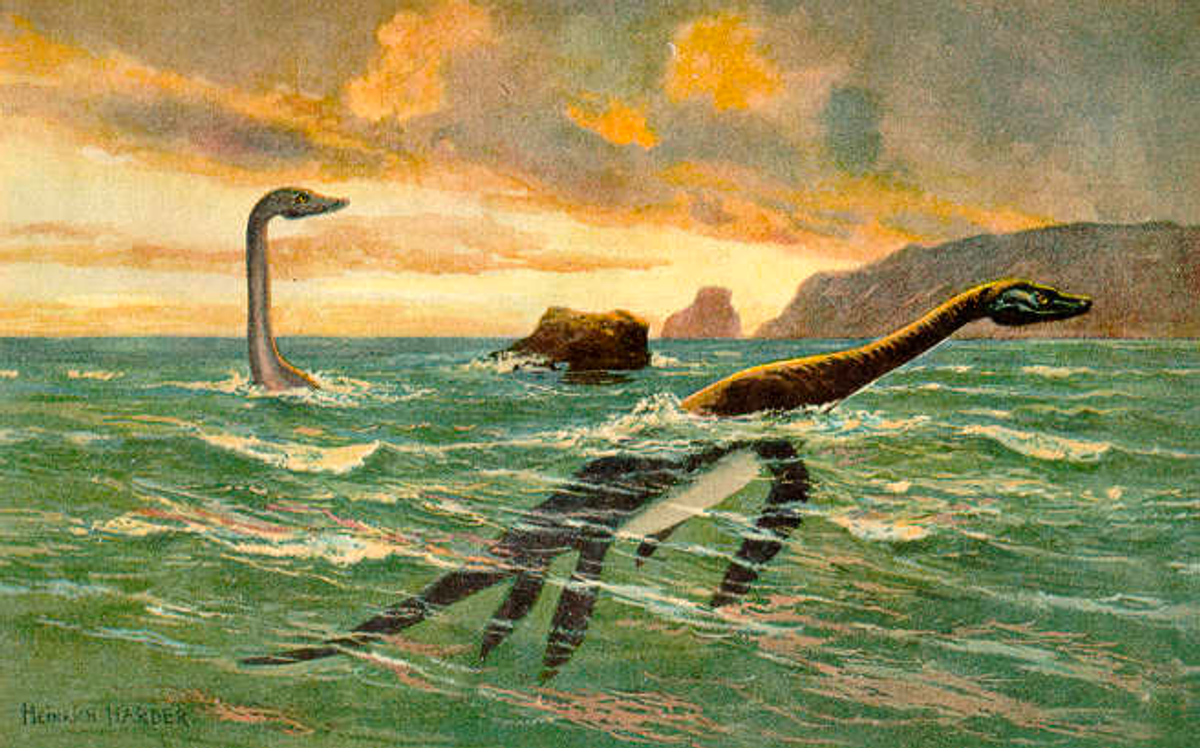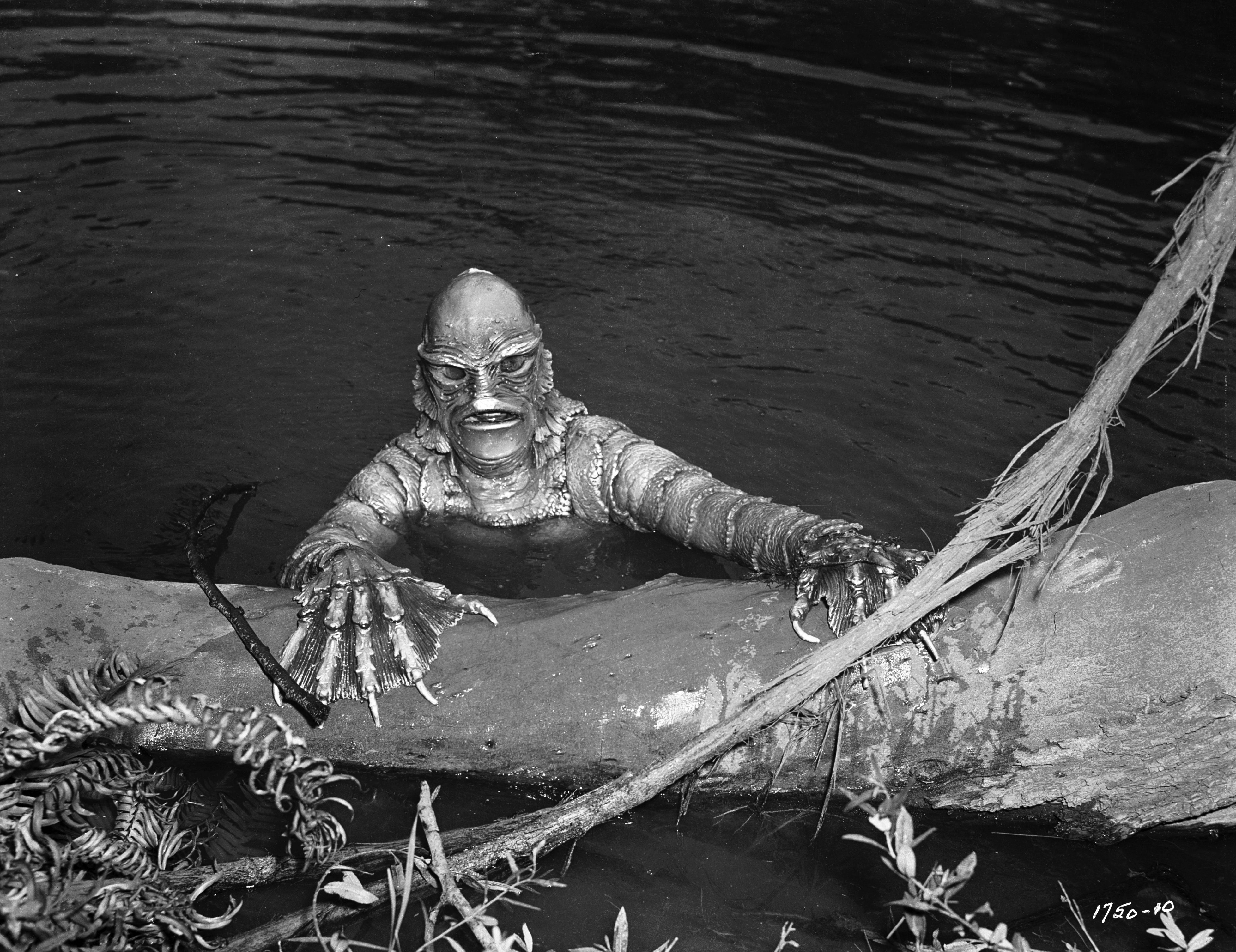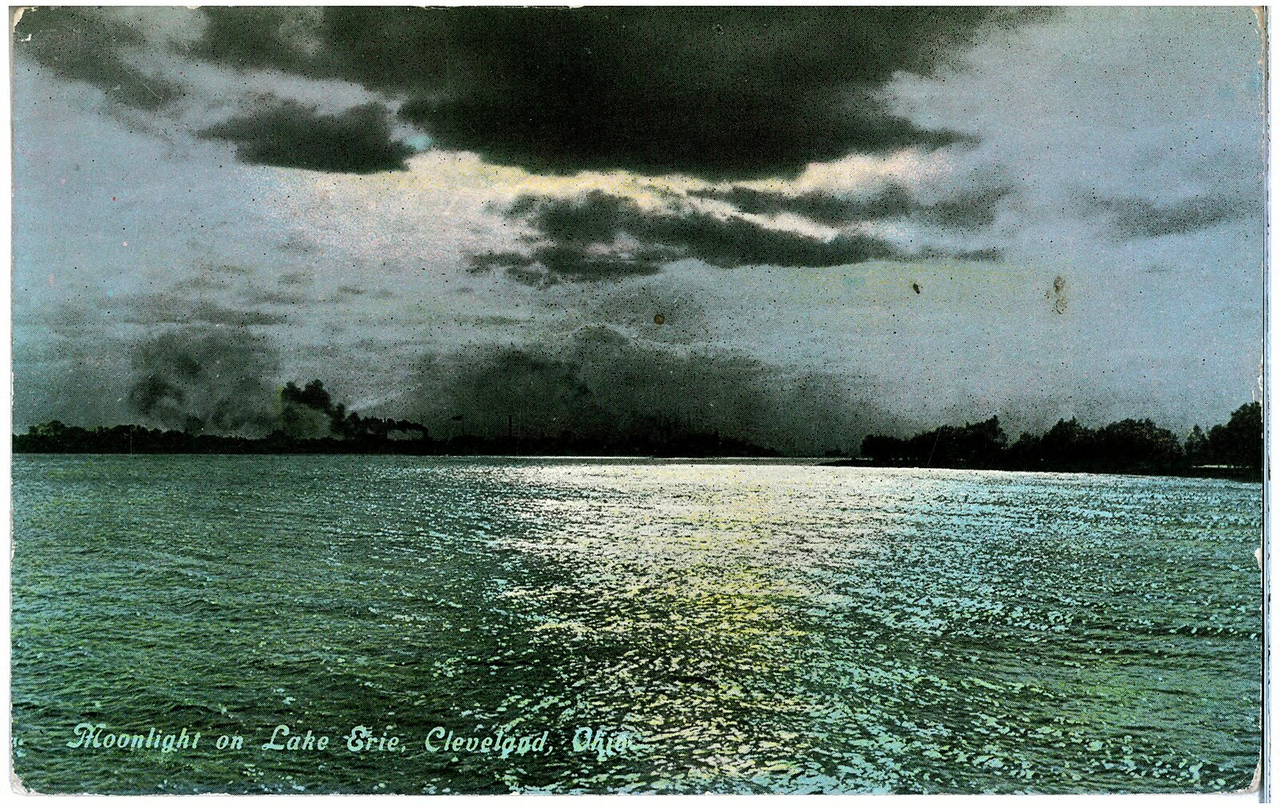Toward a Unifying Theory of Lake Monsters
From Champ to Bessie to lake sturgeon, these cryptids represent what lies beneath the surface of the familiar.

On Fourth of July weekend in 1993, Charles Douglas was out on Lake Erie, along the U.S.-Canadian border, fishing for perch, when he first saw something dark, just under the surface of the water. It was, he estimated, about 30 feet long, and moving fast. He gunned his boat’s engine up to 30 knots, but the thing—whatever it was—kept pace. Twice he turned his boat around and tried to drive towards it, only to watch it disappear.
Douglas was not the first to see something in the waters of Lake Erie. Affectionately dubbed “Bessie,” the Lake Erie water monster has been a presence for more than a century. In July 1892, a steamboat captain named Jenkins first reported seeing something he thought was a wreck of some kind, though as he approached it revealed itself to be a “huge serpent about thirty feet or more in length.” Its tail, he stated, was “laterally compressed,” allowing it to propel itself swiftly through the water; its head was nearly a foot in length and its eyes were “blazing like two balls of fire.” The serpent followed Jenkins’s steamer Fenton for over 20 miles, keeping pace with its head and neck fully out of the water, as though it might attack the boat at any moment, before finally swimming off.
Other sightings followed, sporadically, sometimes in clumps. Ken Golic had been fishing off a pier in Sandusky, Ohio, in 1960, when he saw a creature he described as cigar-shaped. Almost a decade later, a man named Jim Schindler stated that some kind of serpent came within six feet of him near South Bass Island. In September 1981, Theresa Kovach of Akron saw a large, snake-like reptile: “It seemed to be playing,” she said. In 1983, Mary M. Landoll went out on her front porch just before dawn. The lake was placid, and from her left she heard a rowing sound and saw what looked like a capsized boat. She claimed to see a creature of some kind, greenish-brown in color, about 40 to 50 feet in length. It had, she said, a long neck and an eye was visible on the side of the head with a grin going up one side. Two summers later, Tony Schill of Avon, Ohio, was boating with friends when they saw it. It was, they said, dark brown and had a flat tail, and Schill claimed that he saw five humps emerge from the water.

Dale Munro of Lorain was also boating when he came face-to-face with the creature. He stated that it had three humps and was black, twice the size of his 16-foot boat. “I know what I saw,” said John Liles, a Huron charter boat captain, stated after a 1983 sighting. “The thing is huge. I didn’t see the head, just the tail flopping in the water toward the end of it.”
Eventually, the Weekly World News seized on the story of the Lake Erie Monster, with a cover depicting a menacing, brontosaurus-like creature snapping a sailboat in half. The absurdity of the image highlights what I think is a salient fact about water monsters: Eyewitnesses rarely describe them as threatening or remotely dangerous. Compare the Weekly World News cover to a far more famous image: the “Surgeon’s Photograph” of the Loch Ness Monster. It is haunting, despite being a hoax, with an almost melancholic sense of desolation: Gray waves around a solitary figure—capturing far better than any horror movie the feeling lake monsters elicit in us. Some witnesses of lake monsters have worried that such animals might to be large enough to capsize a boat, but beyond that, no one seems terribly afraid. Instead, witnesses seem to marvel at these creatures’ sudden presence, they way they erupt out of the stillness into our field of vision.
Monsters have always been with us. Often they have been things that exist on the borderlands, the edges of the map, beyond civilization. In medieval maps, the Latin phrase hic sunt dracones—“Here be dragons”—was often used to demarcate uncharted areas. Now, when one thinks of cryptids and aliens—today’s dragons or sea monsters, you could say—they tend to cluster in the wilderness.

Lakes, on the other hand, are often close by, part of the fabric of everyday life—not remote or remotely exotic. And yet we have Champ in Lake Champlain; Ogopogo, Igopogo, and Manipogo in Canada, to say nothing, of course, of the alleged denizen of Loch Ness in Scotland. The fact that there are so many lake monsters to be found speaks, perhaps, to the profound unquiet we have about the waters surrounding us.
Above the surface, we presume complete control over lakes: waterways for commerce, the transportation of goods, recreation, and sports. But the murky depths remain unknown, a foreign terrain. To see a strange animal breaking the surface of a lake is to feel the eerie presence of another realm breaking through, from the unknowable world below, troubling our serene understanding of water.
Almost as soon as we see such unsettling sights in such familiar places, we seem to want to domesticate them. We call them “Bessie,” “Champ,” or “Nessie.” (Bigfoot, it should be noted, will never be called “Biggie.”) We’ll do whatever we can to dull the unnerving sensation. The prevalence of lake monster sightings, and the way we immediately try to render them harmless reflects, I think, our ambivalence about bodies of water themselves. Our closeness to places we can never fully plumb means we must immediately do whatever we can to suppress that discomfort.
Late critic and cultural theorist Mark Fisher defined the “eerie” (as we have discussed here before) as the feeling of there being presence where there should be absence, or absence where there should be presence. He cites examples from film and literature, including Daphne du Maurier’s story “The Birds” (the basis for Alfred Hitchcock’s adaptation), in which “the birds cease to be part of the natural background and assert an agency of their own, but the nature of this agency remains mysterious,” writes Fisher. As the story’s protagonist Nat Hocken watches the flocks assemble, he notes “rooks, crows, jackdaws, magpies, jays, all birds that usually preyed upon the smaller species; but this afternoon they were bound on some other mission.” Theories are offered—hunger, a sudden Arctic wind, some form of Soviet malfeasance, but all are inadequate. The story’s real terror is existential. As Fisher explains, “What the birds threaten is the very structures of explanation that had previously made sense of the world.”*

It is the same with lake monsters, though perhaps an even deeper, more primal unease lies beneath these sightings. In July 1609, when French explorer Samuel de Champlain came to the lake the Abenaki called Pitawbagok and the Mohawk called Caniaderi Guarunte (the lake which now also bears his name), he recorded seeing strange sea creatures “five feet long, which were as big as my thigh, and had a head as large as my two fists, with a snout two feet and a half long, and a double row of very sharp, dangerous teeth.” The body, he went on to write, “has a good deal the shape of the pike; but it is protected by scales of a silvery gray colour and so strong that a dagger could not pierce them.”
Was it Champ he saw? Or, more likely, was it what we now know as the lake sturgeon? Despite vociferous denials by some eyewitnesses—“No way it was a sturgeon,” sighter Tony Schill told reporters—the sturgeon continues to lurk in the background of the history of lake cryptids.
Lake sturgeon are slow-moving fish that migrate up rivers during spawning season. It can take them years, sometimes decades, before they’re mature enough to sexually reproduce, but left undisturbed they’ll live long: male sturgeons around 50 to 60 years, females up to 150. Adults are regularly in excess of seven feet long, and weigh up to 240 pounds.
Biologist David Davies, who spent years on Lake Erie working for the Ohio Division of Wildlife, is among the skeptics who think that the Bessie sightings are, in fact, sturgeon. “They do look prehistoric,” Davies told a local reporter when asked why the fish might be confused with something more exotic. “In fact, they very much resemble their prehistoric ancestors.”

The story of the lake sturgeon over the last 200 years is one of those all-too-common cautionary tales about how casually and recklessly humans treat their environment. As W.B. Scott and E.J. Crossman put it in their 1973 guidebook, Freshwater Fishes of Canada, no other freshwater fish “had such a kaleidoscopic relation to man.” In the early 19th century, the sturgeon was dismissed as a nuisance that disturbed traps laid for more commercially valuable species. As Scott and Crossman state, before 1860 the fish, when incidentally caught by commercial fishermen, was “killed and dumped back in the lake, piled upon shore to dry and be burned, fed to pigs, or dug into the earth as fertilizer. It was even stacked like cordwood on the wood dock at Amherstburg, Ont., and used to fire the boilers of steamboats plying the Detroit River.”
This attitude reversed in the second half of the 19th century, when people began to prize sturgeon meat and harvest its eggs for caviar. Between 1879 and 1900, the Great Lakes commercial sturgeon fishery brought in an average of four million pounds per year. This newfound love of the sturgeon was completely unsustainable: Lakes where fishermen had once taken several million pounds of the fish each year were soon emptied. By 1957, for example, the catch in Lake of the Woods, once known as the largest sturgeon hole in the world, was around 0.0005 percent of its 1893 take. Along with industrial pollution and habitat destruction, overfishing destroyed the population. The lake sturgeon is now protected in nearly all of its remaining habitats, and conservationists are attempting to restore the population to its former glory someday. But it’s slow work to save a fish that takes over a decade to reach sexual maturity, work that requires constant monitoring and human intervention.
The decline and fall of the sturgeon in North American waterways is a story of how humans view the natural world. First, the sturgeon was a curiosity, then a nuisance, then a commodity, and now a symbol of industrial folly and humanity’s rapaciousness. In each iteration, the sturgeon exists only as it relates to us; we remain the protagonist in this fish story, whether we’re destroying it or belatedly trying to keep it alive.

Perhaps we’re not used to seeing the sturgeon have a life of its own, have its own story, one that we play very little part in. Perhaps that’s why we don’t recognize it, and see instead something strange and eerie, a sudden presence that we can’t quite make sense of. A thing we then give cute nicknames to, to once again bring it back into the realm of the familiar and homey. That the natural world could have an existence of its own, without our intervention, perspective, or even notice, that we ourselves might not be the central players in the drama of life—what could cause more existential dread? Indeed, what could be more eerie?
* The Hitchcock adaptation lacks this same eerie quality, I think, because (Hitchcock being Hitchcock), it’s so overtly psychosexual: The birds’ behavior is inexplicable, of course, but the movie goes to great lengths to reiterate that Tippi Hedren’s Melanie Daniels is too assertive and obvious in her sexual pursuit of Rod Taylor’s Mitch Brenner. The birds arise to subdue her back into a state of feminine passivity, so she can be rescued by Brenner and the patriarchal balance restored. This obvious metaphor is absent from du Maurier’s story, and as such the story unsettles in a different way.
Colin Dickey is the author of five books of nonfiction, including Ghostland: An American History in Haunted Places, and, most recently, Under the Eye of Power: How Fear of Secret Societies Shapes American Democracy. He also hosts Atlas Obscura’s Monster of the Month.













Follow us on Twitter to get the latest on the world's hidden wonders.
Like us on Facebook to get the latest on the world's hidden wonders.
Follow us on Twitter Like us on Facebook